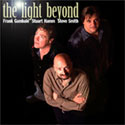The Light Beyond: Liner Notes
 Reports
of fusion's death have been greatly exaggerated.
The cultural phenomenon, by which jazz and rock
made a potent alliance during the '70s,
generally slipped out of the public ear and
major label consciousness, as jazz as a whole
retreated into a more historicist, unplugged
attitude. But out of corporate sight only out of
corporate mind, and musicians have been courting
the fusion muse on indie labels and just beneath
the surface of mainstream jazz marketing ever
since its heyday. Reports
of fusion's death have been greatly exaggerated.
The cultural phenomenon, by which jazz and rock
made a potent alliance during the '70s,
generally slipped out of the public ear and
major label consciousness, as jazz as a whole
retreated into a more historicist, unplugged
attitude. But out of corporate sight only out of
corporate mind, and musicians have been courting
the fusion muse on indie labels and just beneath
the surface of mainstream jazz marketing ever
since its heyday.
In a sense, fusion has
gone underground, but the path continues.
Witness this recording, a fortuitous meeting of
three players with no trepidation about mixing
up jazz sophistication, rock-ish pyrotechnics,
metric and harmonic experimentation, high-octane
blowing and, not lastly, an abiding musicality.
In this trio, the parts inform and interact with
the whole.
To the general public, Steve
Smith is known as the drummer for arena rock
outfit Journey, but his life in jazz is what
counts, artistically. With his band Vital
Information, Smith has explored assorted
sub-idioms within the fusion arena. Stu Hamm has
become a bassist-of-choice in many post-fusion
situations, often where the rock elements is
punched up in the mix, as heard with Joe
Satriani and Steve Vai. Frank Gambale's blend of
fretboard fireworks and an emotive palette has
graced Chick Corea's Electrik Band and his own
multiple projects.
Apart, each player has
solidified his place in the pantheon of
instrumentalists on the latter-day fusion scene.
Together, they generate a special kind of energy
and sensitivity. Some particular empathetic bond
was apparent from the evidence on their debut as
a trio, on the 1998 Tone Center album, Show Me
What You Can Do. Before then, the players had
played with each other in different encounters,
but the idea here-one of a few "power trio"
dates organized by Smith for Tone Center -- was
to celebrate the artistic possibilities of the
plugged-in trio format. The Gambale-Hamm-Smith
sessions were especially juicy, and the first
album met with positive reaction on the audience
back end.
"That seemed like a great
idea," Smith said of the first meeting. "Both of
these records came about in a similar way, in
that we would go in the studio and set aside
nine to ten days to write and record--a tune a
day. The first time around, it felt to me like
there was a bit less writing and more jamming.
On this one, the writing seemed to come to the
forefront more. The tunes are stronger. One of
the reasons is that we didn't write all of the
tunes in the studio, the way we did on the first
record."
If there were more preconceived
pieces thrown into the machinery this time out,
a premium was still placed on the importance of
improvising and tailoring. "The tunes that are
written offer a loose framework, but then we
arrange it and claim it to be our own, and also
leave a lot of space for improvising, for
everyone. There are a lot of drum and bass
solos, and a lot of guitar solos."
The
trio went into Neverland Studio in Marin, in
Northern California, for a stretch of days in
February, 2000, and came away with another step
up in the evolution of the group. On many
levels, the secret is in the mix, of players'
input into the interactive blend, of varied
material, and even levels of restraint. Therein
lies the underlying code of good music-making:
knowing when to wait, when to wail. They know.
Does history repeat or reinvigorate itself,
or both? Thinking of reference points, one could
refer back to Tony Williams' 1970s work around
the time of the album "Believe It."
"That's a good reference point," Smith comments,
"although this music is pretty unique. I don't
know exactly why, other than the combination of
players and the material itself. It's modern,
yet you can hear that its inspiration dates back
to the '70s fusion experience. But the writing
still sounds current and modern, as far as I'm
concerned. It has a unique feeling to it.
"There's a lot of melody involved in most of
the tunes, and the melodies are not that
obscure, or totally jazz fusion melodies. For
the most part, the material is fairly melodic,
but without being sappy. It's somehow a fine
line that really works, through strong melodies
and rhythmic foundation."
Fans of
fusion's promise won't be left wanting.
-- Adapted from the liner notes by Josef
Woodard

Click here to return to the top of the
page. |
|

Use the
navigation
buttons,
below,
to shop
for
specific
kinds of
products.
Questions?
Write
to:
custserv@vitalinformation.com
Click
here
to
return
to the
Fusion
store
page. |
|

